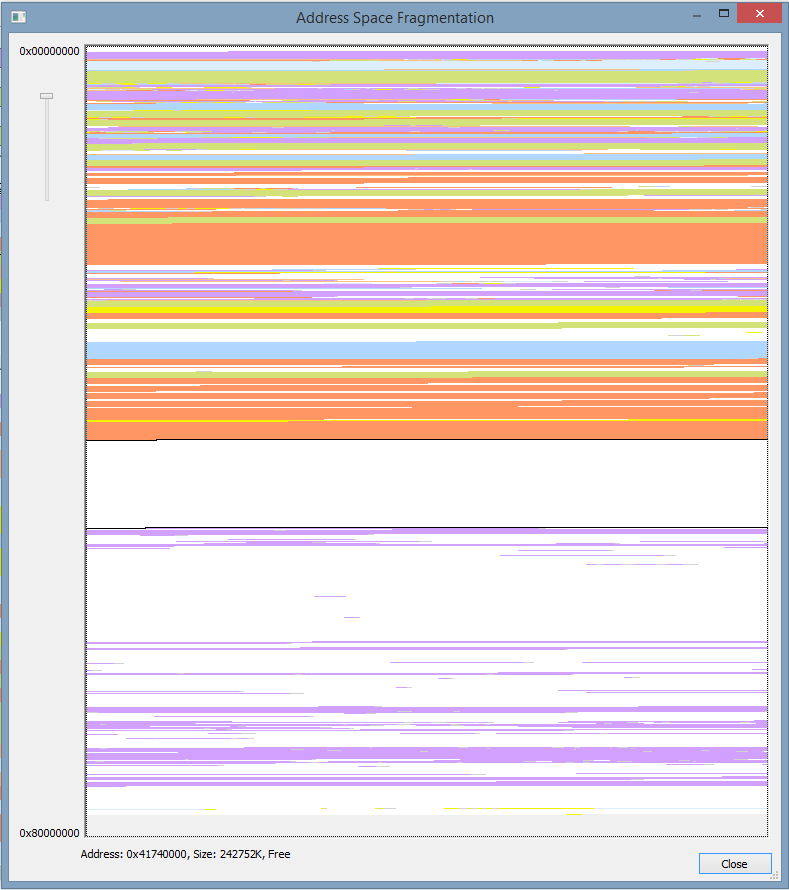SharpDX内存碎片
我正在开发一个.NET 3.5应用程序,它使用SharpDX来呈现平铺的2D图像。
纹理(Texture2D)按需加载到缓存中,并在托管池中创建.
纹理将在不再需要时被处理,并且我已经验证了that ()是否被正确调用。SharpDX对象跟踪表明没有最终确定纹理。
问题是,纹理使用的大量非托管堆内存在处理后继续保留。此内存在加载新纹理时被重用,因此内存不会泄漏。
然而,应用程序的另一部分也需要大量内存来处理新图像。因为这些堆仍然存在,即使已经处理了纹理,也没有足够的连续内存来加载另一个映像(可以是数百MB)。
如果我使用AllocHGlobal分配非托管内存,则生成的堆内存在调用FreeHGlobal后再次完全消失。

VMMap显示应用程序大量使用后的非托管堆(red)。

我们在这里可以看到,非托管堆占了~380 at,尽管此时实际上只提交了~20 at。
从长远来看,该应用程序正在移植到64位。但是,由于非托管依赖关系,这并不简单。而且,不是所有的用户都在64位的机器上。
编辑:--我已经为这个问题做了演示--创建一个WinForms应用程序,并通过Nuget安装SharpDX 2.6.3。
Form1.cs:
using System.Collections.Generic;
using System.Diagnostics;
using System.Windows.Forms;
using SharpDX.Direct3D9;
namespace SharpDXRepro {
public partial class Form1 : Form {
private readonly SharpDXRenderer renderer;
private readonly List<Texture> textures = new List<Texture>();
public Form1() {
InitializeComponent();
renderer = new SharpDXRenderer(this);
Debugger.Break(); // Check VMMap here
LoadTextures();
Debugger.Break(); // Check VMMap here
DisposeAllTextures();
Debugger.Break(); // Check VMMap here
renderer.Dispose();
Debugger.Break(); // Check VMMap here
}
private void LoadTextures() {
for (int i = 0; i < 1000; i++) {
textures.Add(renderer.LoadTextureFromFile(@"D:\Image256x256.jpg"));
}
}
private void DisposeAllTextures() {
foreach (var texture in textures.ToArray()) {
texture.Dispose();
textures.Remove(texture);
}
}
}
}SharpDXRenderer.cs:
using System;
using System.Linq;
using System.Windows.Forms;
using SharpDX.Direct3D9;
namespace SharpDXRepro {
public class SharpDXRenderer : IDisposable {
private readonly Control parentControl;
private Direct3D direct3d;
private Device device;
private DeviceType deviceType = DeviceType.Hardware;
private PresentParameters presentParameters;
private CreateFlags createFlags = CreateFlags.HardwareVertexProcessing | CreateFlags.Multithreaded;
public SharpDXRenderer(Control parentControl) {
this.parentControl = parentControl;
InitialiseDevice();
}
public void InitialiseDevice() {
direct3d = new Direct3D();
AdapterInformation defaultAdapter = direct3d.Adapters.First();
presentParameters = new PresentParameters {
Windowed = true,
EnableAutoDepthStencil = true,
AutoDepthStencilFormat = Format.D16,
SwapEffect = SwapEffect.Discard,
PresentationInterval = PresentInterval.One,
BackBufferWidth = parentControl.ClientSize.Width,
BackBufferHeight = parentControl.ClientSize.Height,
BackBufferCount = 1,
BackBufferFormat = defaultAdapter.CurrentDisplayMode.Format,
};
device = new Device(direct3d, direct3d.Adapters[0].Adapter, deviceType,
parentControl.Handle, createFlags, presentParameters);
}
public Texture LoadTextureFromFile(string filename) {
using (var stream = new FileStream(filename, FileMode.Open, FileAccess.Read)) {
return Texture.FromStream(device, stream, 0, 0, 1, Usage.None, Format.Unknown, Pool.Managed, Filter.Point, Filter.None, 0);
}
}
public void Dispose() {
if (device != null) {
device.Dispose();
device = null;
}
if (direct3d != null) {
direct3d.Dispose();
direct3d = null;
}
}
}
}因此,我的问题是-(如何)在纹理被释放之后,我如何回收这些非托管堆所消耗的内存?
回答 1
Stack Overflow用户
发布于 2015-07-03 14:37:38
给出问题的内存似乎是由nVidia驱动程序分配的。据我所知,所有的去分配方法都是正确调用的,所以这可能是驱动程序中的一个bug。环顾互联网,可以看到一些似乎与此相关的问题,尽管这还不够严重,不值得参考。我不能在ATi卡上测试这个(我已经有十年没见过了)。
看来你的选择是:
- 确保你的纹理足够大,不能在“共享”堆上分配。这使得内存泄漏进行得慢得多--尽管它仍然是未释放的内存,但它不会像您所经历的那样严重地导致内存碎片。你说的是绘制瓷砖--这在历史上是用分蘖做的,这给了你更好的处理能力(尽管它们也有缺点)。在我的测试中,简单地避免微小的纹理几乎消除了这个问题--很难判断它是隐藏的还是完全消失的(两者都是非常可能的)。
- 在单独的进程中处理处理。您的主应用程序将在需要时启动另一个进程,当助手进程退出时,内存将被正确地回收。当然,这只有在您编写一些处理应用程序时才有意义--如果您正在制作一些实际显示纹理的东西,这不会有帮助(或者至少设置起来会非常棘手)。
- 不要处理纹理。
Managed纹理池为您处理从设备到设备的分页操作,它甚至允许您使用优先级等,以及刷新整个设备上(托管)内存。这意味着纹理将保留在您的进程内存中,但与当前的方法相比,您仍然可以获得更好的内存使用:) - 可能,这些问题可能只与DirectX 9上下文有关。您可能需要使用一个较新的接口进行测试,比如DX10或DXGI。这并不一定限制您使用DX10+ GPUs -但您将失去对Windows的支持(无论如何,它不再受支持)。
https://stackoverflow.com/questions/31186093
复制相似问题

